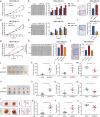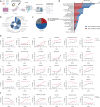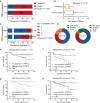PRR15 deficiency facilitates malignant progression by mediating PI3K/Akt signaling and predicts clinical prognosis in triple-negative rather than non-triple-negative breast cancer
- PMID: 37072408
- PMCID: PMC10113191
- DOI: 10.1038/s41419-023-05746-8
PRR15 deficiency facilitates malignant progression by mediating PI3K/Akt signaling and predicts clinical prognosis in triple-negative rather than non-triple-negative breast cancer
Abstract
Triple-negative breast cancer (TNBC) is the most aggressive subtype of breast neoplasms with a higher risk of recurrence and metastasis than non-TNBC. Nevertheless, the factors responsible for the differences in the malignant behavior between TNBC and non-TNBC are not fully explored. Proline rich 15 (PRR15) is a protein involved in the progression of several tumor types, but its mechanisms are still controversial. Therefore, this study aimed to investigate the biological role and clinical applications of PRR15 on TNBC. PRR15 gene was differentially expressed between TNBC and non-TNBC patients, previously described as an oncogenic factor in breast cancer. However, our results showed a decreased expression of PRR15 that portended a favorable prognosis in TNBC rather than non-TNBC. PRR15 knockdown facilitated the proliferation, migration, and invasive ability of TNBC cells in vitro and in vivo, which was abolished by PRR15 restoration, without remarkable effects on non-TNBC. High-throughput drug sensitivity revealed that PI3K/Akt signaling was involved in the aggressive properties of PRR15 silencing, which was confirmed by the PI3K/Akt signaling activation in the tumors of PRR15Low patients, and PI3K inhibitor reversed the metastatic capacity of TNBC in mice. The reduced PRR15 expression in TNBC patients was positively correlated with more aggressive clinicopathological characteristics, enhanced metastasis, and poor disease-free survival. Collectively, PRR15 down-regulation promotes malignant progression through the PI3K/Akt signaling in TNBC rather than in non-TNBC, affects the response of TNBC cells to antitumor agents, and is a promising indicator of disease outcomes in TNBC.
© 2023. The Author(s).
Conflict of interest statement
The authors declare no competing interests. Animal studies were approved by the Ethical Committee for animal experiments of Cancer Hospital, Chinese Academy of Medical Science (NCC2022A369). The protocol regarding human participants was approved by the Ethical Committee of CHCAMS (NCC2022C-299) and informed consents were obtained from patients involved.
The authors declare no competing interests.
Figures





Similar articles
-
Targeting PRDX2 to inhibit tumor growth and metastasis in triple-negative breast cancer: the role of FN1 and the PI3K/AKT/SP1 pathway.J Transl Med. 2025 Apr 11;23(1):434. doi: 10.1186/s12967-025-06441-2. J Transl Med. 2025. PMID: 40217291 Free PMC article.
-
Type X collagen knockdown inactivate ITGB1/PI3K/AKT to suppress chronic unpredictable mild stress-stimulated triple-negative breast cancer progression.Int J Biol Macromol. 2024 Jul;273(Pt 1):133074. doi: 10.1016/j.ijbiomac.2024.133074. Epub 2024 Jun 10. Int J Biol Macromol. 2024. PMID: 38866293
-
Hsa_circ_0000199 facilitates chemo-tolerance of triple-negative breast cancer by interfering with miR-206/613-led PI3K/Akt/mTOR signaling.Aging (Albany NY). 2021 Jan 20;13(3):4522-4551. doi: 10.18632/aging.202415. Epub 2021 Jan 20. Aging (Albany NY). 2021. PMID: 33495420 Free PMC article.
-
Impact of microRNA variants on PI3K/AKT signaling in triple-negative breast cancer: comprehensive review.Med Oncol. 2024 Aug 9;41(9):222. doi: 10.1007/s12032-024-02469-4. Med Oncol. 2024. PMID: 39120634 Review.
-
Myricetin-induced apoptosis in triple-negative breast cancer cells through inhibition of the PI3K/Akt/mTOR pathway.Med Oncol. 2022 Oct 8;39(12):248. doi: 10.1007/s12032-022-01856-z. Med Oncol. 2022. PMID: 36209343 Review.
Cited by
-
Integrated bulk and single-cell transcriptomic analysis unveiled a novel cuproptosis-related lipid metabolism gene molecular pattern and a risk index for predicting prognosis and antitumor drug sensitivity in breast cancer.Discov Oncol. 2025 Mar 14;16(1):318. doi: 10.1007/s12672-025-02044-x. Discov Oncol. 2025. PMID: 40085377 Free PMC article.
-
Molecular mechanisms of polychlorinated biphenyls in breast cancer: insights from network toxicology and molecular docking approaches.Front Pharmacol. 2025 Jun 13;16:1604993. doi: 10.3389/fphar.2025.1604993. eCollection 2025. Front Pharmacol. 2025. PMID: 40584614 Free PMC article.
-
The expression and functional role of proline-rich 15 in non-small cell lung cancer.Cell Death Dis. 2025 Feb 10;16(1):83. doi: 10.1038/s41419-025-07373-x. Cell Death Dis. 2025. PMID: 39929816 Free PMC article.
References
-
- Davies C, Pan H, Godwin J, Gray R, Arriagada R, Raina V, et al. Long-term effects of continuing adjuvant tamoxifen to 10 years versus stopping at 5 years after diagnosis of oestrogen receptor-positive breast cancer: ATLAS, a randomised trial. Lancet. 2013;381:805–16. doi: 10.1016/S0140-6736(12)61963-1. - DOI - PMC - PubMed
Publication types
MeSH terms
Substances
LinkOut - more resources
Full Text Sources
Molecular Biology Databases

